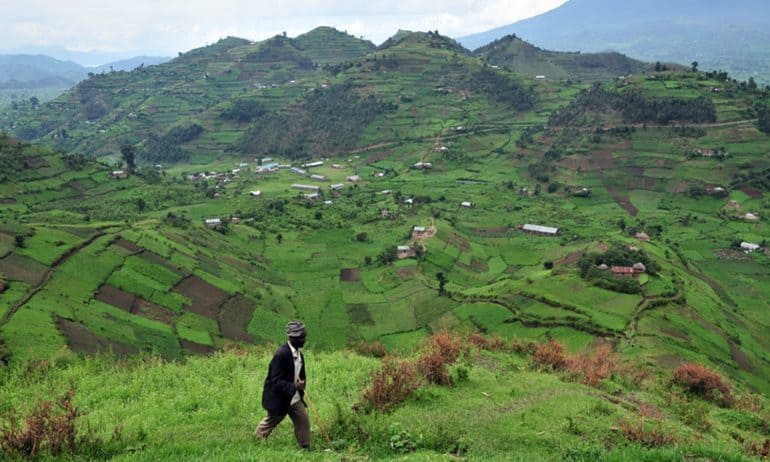Imagine one hundred years ago if farmers had access to huge volumes of information about the soil profile of their land, the varieties of crops they were growing, and even the fluctuations of their local climate. This kind of information could have prevented an environmental crisis like the Dust Bowl of the 1920s in the American Midwest. But even ten years ago, the idea that farmers could have access to this kind of information was unrealistic.
For the team behind the CGIAR Platform for Big Data in Agriculture, farming is the next frontier for using artificial intelligence (AI) to efficiently solve complex problems. The team—which includes biologists, agronomists, nutritionists, and policy analysts working with data scientists—is using Big Data tools to create AI systems that can predict the potential outcomes of future scenarios for farmers. By leveraging massive amounts of data and using innovative computational analysis, the CGIAR Platform is working to help farmers increase their efficiency and reduce the risks that are inherent in farming.
The idea behind the CGIAR Platform is to first create a better way for researchers to manage and share agricultural data. This is a huge project by itself, but the Platform is aiming to be more than just a library of research data. The ultimate goal is to seamlessly integrate real-world data from farms around the world into algorithms that generate critical insights that can then be shared back with farmers.
Silicon Valley is also using AI to impact agriculture, but these companies tend to focus more on the technological aspect than on the agricultural aspect. These technologies include innovations like indoor farms and robotic harvesters, equipment that require significant investment and resources. Much of the work done by CGIAR focuses on smallholder farmers in the developing world, and many of these farmers lack access to even basic technologies such as irrigation. Collaborations between CGIAR and the private sector, though, could be a powerful way to leverage the mission of ending world hunger with the resources and incentives of these high-tech enterprises. For example, a recent report from the George Washington University Food Institute describes effective ways to deploy indoor farming technology for smallholder farmers in conflict zones.
Smallholder farmers grow about 70 percent of the world’s food supply on farms that are less than one hectare—these farmers are critical to the global food system. And these farmers in the developing world will benefit the most from the CGIAR Platform for Big Data in Agriculture.
“One way to use these tools for smallholder farmers is to create probabilistic models for seasonal forecasting,” says Andy Jarvis, a researcher at the CGIAR Research Program for Climate Change, Agriculture and Food Security (CCAFS) and one of the founders of the CGIAR Platform for Big Data in Agriculture. “If done properly, we can look six months in advance and provide farmers with simple information: what crop varieties will be suitable for the season, when they should plant, and how they can optimize their farm management based on weather patterns during the season.”
Jarvis and Daniel Jiménez, a researcher at the International Center for Tropical Agriculture (CIAT) and a leader on the CGIAR Platform, describe how these models could be developed: “If it were possible to characterize a crop production system in terms of management and environmental conditions, and if information were collected on the management, environment, and resulting harvest for the crop, it should be possible to develop data-driven models that describe the production system.” The innovation of Big Data is to inform these model with thousands of plantings under different management and environmental conditions and then to analyze the corresponding harvests and develop insights into the relationship between these agricultural and environmental factors and the resulting harvest.
But there are many variables that must be considered simultaneously, including soil nutrients, seed bed preparation, germination rate, irrigation, cultivation, minerals, microorganisms, pests, and disease. The data is not only big in terms of volume but also in terms of the number of variables that must be linked and layered to accurately simulate the complex system of a farm.
The CGIAR Platform is already showing results of potential benefits for smallholder farmers, such as for the Colombian Rice Farmers Federation. After multiple seasons of challenging rain patterns, rice farmers in Colombia were struggling to know when to plant their crop. Depending on whether there was going to be above average or below average rainfall, farmers would need to decide whether to plant earlier or later in the season. If there was going to be too much rain, they might decide not to plant at all that season.
The risks and trade-offs of these decisions are significant: if a farmer invests in planting a crop and the harvest fails, the financial impact of that loss can have serious consequences for the farmer’s business. But how can a farmer predict how much rain there will be?
In a pilot project for the Platform for Big Data in Agriculture, researchers from CGIAR were able to help the rice farmers by aggregating local weather data as well as rice production data for the region. They ran this large volume of data through a climate model that could project the prevailing trend of rainfall for the region as well as analyze the viability of a rice crop in varying amounts of rain. For that season, the researchers recommended that the farmers delay planting until the next season. And sure enough, there was a huge amount of rain that season—enough rain to ruin a rice crop. Through the use of this Big Data methodology, the CGIAR Platform was able to respond to an urgent problem and provide critical guidance to help these farmers.















